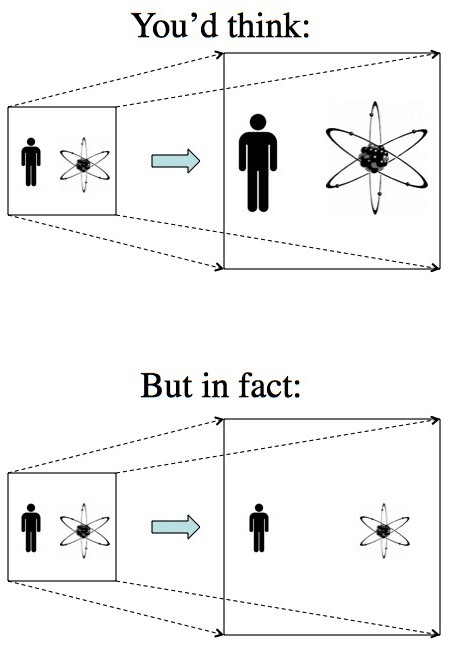Physicist: Way back in the day Edwin Hubble (of telescope fame) noticed that the farther away a galaxy is, the faster it’s moving away from us. From this he figured out that the universe is expanding, but in a very specific, weird way. Rather than things just flying apart (like debris from an explosion), the space between things is actually increasing on its own.
There’s some detail on what the difference is over here.
You’d think that, what with space itself expanding, everything else would expand with it. After all, the expansion of space is roughly analogous to a stretching rubber sheet. If you stretch the sheet anything drawn on it will stretch just as much.
But in fact, while the space between and inside everything increases, the things themselves don’t. Or at least, they snap back faster than they can be stretched. The size of atoms, their chemical bonds, and by extension everything that’s composed of them, is determined by physical laws and constants. For example, the size of electron orbitals is scaled by the Bohr radius, a0,which is just fit to pop with physical constants. , where
,
,
,
, and
are all constants, etched indelibly into the fabric of the universe, and none of them are terribly concerned with the amount of space around.
So everything around is the size it’s “supposed to be”. At least, everything solid. Fluffier things, like stars, gas clouds, and whatnot tend to have a particular stable size. As space expands a star in that space will expand as well. However, with a drop in density comes a drop in the fusion rate, the core cools a little, and the star is free to collapse back into its preferred equilibrium size. The same idea applies to chemical bonds: atoms in any given molecule like to be a set distance from each other, and while the expansion of space may move them slightly farther apart then they’d like, they have no trouble at all returning to their original distance.
It’s worth noting that this isn’t the sort of thing that anyone would need to worry about / include in any calculations / talk about publicly. Right now the universe is expanding at the rate of approximately 72 (km/s)/Mpc (“kilometers per second per megaparsec”). This rate is called the “Hubble Constant“, which is a weird name, considering that over the history of the universe it hasn’t been constant. Unlike other physical constants, which are constant. This expansion rate means that distances increase in size by about 0.0000000074% every year. On the scale of the universe (45 billion of light years, give or take) that expansion is important. On the scale of our galaxy (100,000 light years), and especially on the scale of people ( light years), that expansion doesn’t mean anything. Your hair grows about 1 billion times faster than the universe “expands you”, and your atoms don’t naturally compensate for hair growth.
That all being said, the Hubble constant doesn’t seem to be constant. In fact it’s increasing. So, in the future the expansion may be noticeable on a smaller scale. At some point, in the inconceivably distant future, the expansion of space may be fast enough to overcome the forces that return matter to equilibrium. Once the gravitational force of a star is overcome it’ll fly apart. Once the electrical forces that maintain chemical bonds is overcome, there goes everything else. This unfortunate occasion, is known as the “Big Rip” to juxtapose it with the “Big Bang”. The jury’s still out on when and if the Big Rip will happen, but it’s a very long way off if it does happen.








Pingback: Big Bang Theory misconceptions | Blog Blogger Bloggest